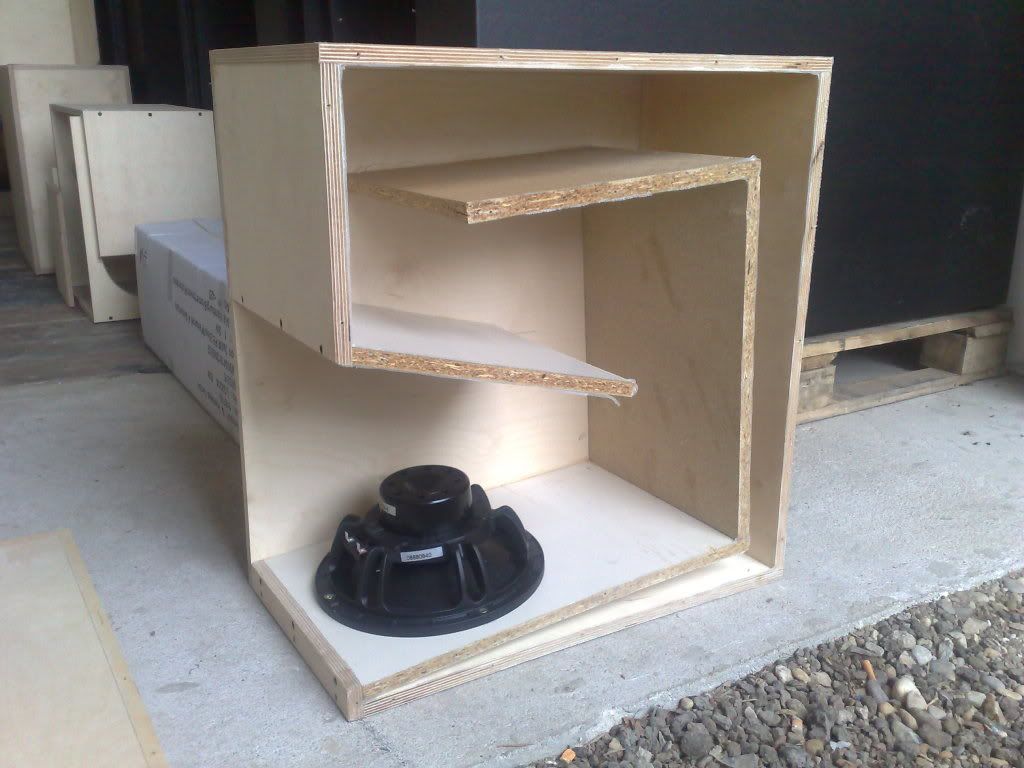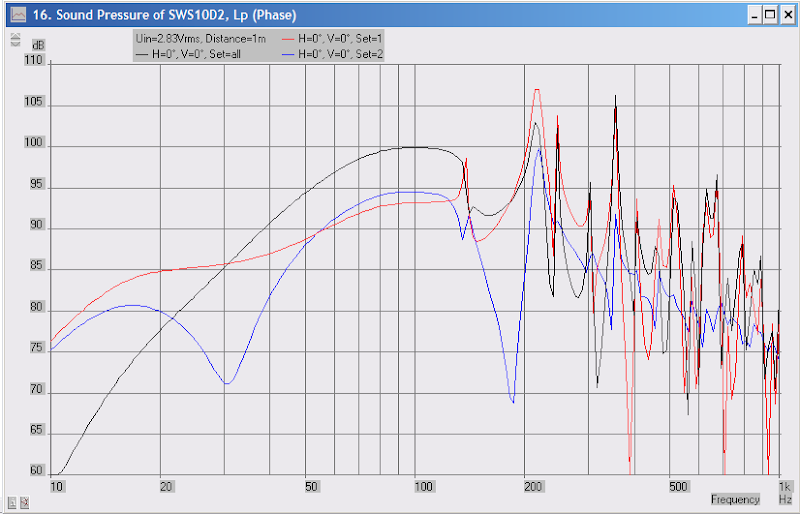I've been faced with a catch-22 lately:
1) I can make a tapped horn that plays really really low, but the box size is insanely large
2) I can make dipole subs that are really really small, but they won't play down to 20hz.
Seemed to me that you could combine these two things, and put a dipole woofer IN a tapped horn. So I did.

The 'cardioid tapped horn' looks virtually identical to this patent from Cerwin Vega. Except the woofer at the throat of the horn isn't in a sealed box, it's a tapped horn.

Here's how the cardioid tapped horn works:
In a tapped horn, we're raising the efficiency of the woofer by (duh) putting it in a horn.
A U-Frame is a type of dipole subwoofer. Because it's a dipole, it has a figure eight radiation pattern.
By combining the tapped horn *and* the U-Frame, you wind up with a cardioid. Same idea as combining a sealed box with a dipole.
The reason that the tapped horn is particularly attractive for this application is because the tapped horn excels at low frequencies, while the dipole does not. The dipole has a small footprint, while the tapped horn does not. Put them together and you have a nice 'yin-yang' combination.

Here's an Akabak sim of the speaker with a single watt. Efficiency is very high above 50hz, because you have both a fifteen and a ten radiating into the same space, and they're tightly coupled. The low frequency efficiency isn't as good as a tapped horn, but it's better than a dipole.

Here's the same speaker, but I've set up labels so you can see the output of the dipole fifteen (in blue), the tapped horn (in red) and the combination (in black.)
Should be a fun / easy sub to build. The tapped horn woofer is an Alpine SWS-10D2, retails for about $100. The dipole woofer is an Alpine SWS-15D2, retails for $125. For this type of sub, you want a BIG woofer for the dipole and a SMALL woofer for the TH. This is because the TH has higher efficiency.
1) I can make a tapped horn that plays really really low, but the box size is insanely large
2) I can make dipole subs that are really really small, but they won't play down to 20hz.
Seemed to me that you could combine these two things, and put a dipole woofer IN a tapped horn. So I did.

The 'cardioid tapped horn' looks virtually identical to this patent from Cerwin Vega. Except the woofer at the throat of the horn isn't in a sealed box, it's a tapped horn.

Here's how the cardioid tapped horn works:
In a tapped horn, we're raising the efficiency of the woofer by (duh) putting it in a horn.
An externally hosted image should be here but it was not working when we last tested it.
A U-Frame is a type of dipole subwoofer. Because it's a dipole, it has a figure eight radiation pattern.
By combining the tapped horn *and* the U-Frame, you wind up with a cardioid. Same idea as combining a sealed box with a dipole.
The reason that the tapped horn is particularly attractive for this application is because the tapped horn excels at low frequencies, while the dipole does not. The dipole has a small footprint, while the tapped horn does not. Put them together and you have a nice 'yin-yang' combination.

Here's an Akabak sim of the speaker with a single watt. Efficiency is very high above 50hz, because you have both a fifteen and a ten radiating into the same space, and they're tightly coupled. The low frequency efficiency isn't as good as a tapped horn, but it's better than a dipole.

Here's the same speaker, but I've set up labels so you can see the output of the dipole fifteen (in blue), the tapped horn (in red) and the combination (in black.)
Should be a fun / easy sub to build. The tapped horn woofer is an Alpine SWS-10D2, retails for about $100. The dipole woofer is an Alpine SWS-15D2, retails for $125. For this type of sub, you want a BIG woofer for the dipole and a SMALL woofer for the TH. This is because the TH has higher efficiency.
Here's the Akabak model.
It's far from perfect; ideally I'd include parameters for where the woofers are physically located. Then again, at these low frequencies, I think the wavelengths are so long, the difference might be slight. XRK971 is way better at Akabak than I am so he might be able to improve on this.
| EXPORTED FROM HORNRESP - RESONANCES NOT MASKED
|COMMENT: SWS-10D2 tapped horn
|~~~~~~~~~~~~~~~~~~~~~~~~~~~~~~~~~~~~~~~~~~~~~~~~~~~~~~~~~~~~~~~~~~~~~~~~~~~~~~~~~~~~~~~~~~~~~~~~~~~~~~~~
|REQUIRED AKABAK SETTINGS:
|File > Preferences > Physical system constants:
|Sound velocity c = 344m/s
|Medium density rho = 1.205kg/m3
|Sum > Acoustic power:
|Frequency range = 10Hz to 20kHz
|Points = 533
|Input voltage = 28.28V rms
|Integration = 2Pi-sr
|Integration steps = 1 degree ... 1 degree
|Integration method = Cross
|~~~~~~~~~~~~~~~~~~~~~~~~~~~~~~~~~~~~~~~~~~~~~~~~~~~~~~~~~~~~~~~~~~~~~~~~~~~~~~~~~~~~~~~~~~~~~~~~~~~~~~~~
Def_Const |Hornresp Input Parameter Values
{
|Length, area and volume values converted to metres, square metres and cubic metres:
S1 = 60.00e-4; |Horn segment 1 throat area (sq m)
S2 = 80.00e-4; |Horn segment 1 mouth area and horn segment 2 throat area (sq m)
S3 = 107.00e-4; |Horn segment 2 mouth area and horn segment 3 throat area (sq m)
S4 = 125.00e-4; |Horn segment 3 mouth area and horn segment 4 throat area (sq m)
S5 = 143.00e-4; |Horn segment 3 mouth area and horn segment 4 throat area (sq m)
S6 = 191.00e-4; |Horn segment 4 mouth area (sq m)
L12 = 25.00e-2; |Horn segment 1 axial length (m)
L23 = 80.00e-2; |Horn segment 2 axial length (m)
L34 = 80.00e-2; |Horn segment 3 axial length (m)
L45 = 80.00e-2; |Horn segment 3 axial length (m)
L56 = 48.00e-2; |Horn segment 4 axial length (m)
|Parameter Conversions:
Sd = 333.00e-4; |Diaphragm area (sq m)
}
|~~~~~~~~~~~~~~~~~~~~~~~~~~~~~~~~~~~~~~~~~~~~~~~~~~~~~~~~~~~~~~~~~~~~~~~~~~~~~~~~~~~~~~~~~~~~~~~~~~~~~~~~
|Network node numbers for this tapped horn system:
| 0-Voltage-1
| |
| -Driver-------------
| | |
|8-Segment-9-Segment-10-Segment-11-Segment-12-Radiator
|~~~~~~~~~~~~~~~~~~~~~~~~~~~~~~~~~~~~~~~~~~~~~~~~~~~~~~~~~~~~~~~~~~~~~~~~~~~~~~~~~~~~~~~~~~~~~~~~~~~~~~~~
Def_Driver 'horn-driver'
Sd=333.00cm2
Bl=18.32Tm
Cms=1.58E-04m/N
Rms=3.82Ns/m
fs=35.00Hz |Mmd = 127.37g not recognised by AkAbak, fs calculated and used instead
Le=3.74mH
Re=3.60ohm
ExpoLe=1
Def_Driver 'dipole-driver'
Sd=779cm2
Bl=18.32Tm
Cms=1.24E-04m/N
Rms=6.18Ns/m
fs=27.00Hz
Le=3.74mH
Re=3.6ohm
ExpoLe=1
System 'System'
Driver Def='horn-driver''driver 1'
Node=1=0=9=12
Driver Def='dipole-driver''driver 2'
Node=1=0=11=14
Waveguide 'Horn segment 1'
Node=8=9
STh={S1}
SMo={S2}
Len={L12}
Conical
Waveguide 'Horn segment 2'
Node=9=10
STh={S2}
SMo={S3}
Len={L23}
Conical
Waveguide 'Horn segment 3'
Node=10=11
STh={S3}
SMo={S4}
Len={L34}
Conical
Waveguide 'Horn segment 4'
Node=11=12
STh={S4}
SMo={S5}
Len={L45}
Conical
Waveguide 'Horn segment 5'
Node=12=13
STh={S5}
SMo={S6}
Len={L56}
Conical
Radiator 'Horn mouth'
Node=13
SD={S6}
label=1
Radiator 'Dipole Radiator'
Node=14
SD=779cm2
label=2
It's far from perfect; ideally I'd include parameters for where the woofers are physically located. Then again, at these low frequencies, I think the wavelengths are so long, the difference might be slight. XRK971 is way better at Akabak than I am so he might be able to improve on this.
| EXPORTED FROM HORNRESP - RESONANCES NOT MASKED
|COMMENT: SWS-10D2 tapped horn
|~~~~~~~~~~~~~~~~~~~~~~~~~~~~~~~~~~~~~~~~~~~~~~~~~~~~~~~~~~~~~~~~~~~~~~~~~~~~~~~~~~~~~~~~~~~~~~~~~~~~~~~~
|REQUIRED AKABAK SETTINGS:
|File > Preferences > Physical system constants:
|Sound velocity c = 344m/s
|Medium density rho = 1.205kg/m3
|Sum > Acoustic power:
|Frequency range = 10Hz to 20kHz
|Points = 533
|Input voltage = 28.28V rms
|Integration = 2Pi-sr
|Integration steps = 1 degree ... 1 degree
|Integration method = Cross
|~~~~~~~~~~~~~~~~~~~~~~~~~~~~~~~~~~~~~~~~~~~~~~~~~~~~~~~~~~~~~~~~~~~~~~~~~~~~~~~~~~~~~~~~~~~~~~~~~~~~~~~~
Def_Const |Hornresp Input Parameter Values
{
|Length, area and volume values converted to metres, square metres and cubic metres:
S1 = 60.00e-4; |Horn segment 1 throat area (sq m)
S2 = 80.00e-4; |Horn segment 1 mouth area and horn segment 2 throat area (sq m)
S3 = 107.00e-4; |Horn segment 2 mouth area and horn segment 3 throat area (sq m)
S4 = 125.00e-4; |Horn segment 3 mouth area and horn segment 4 throat area (sq m)
S5 = 143.00e-4; |Horn segment 3 mouth area and horn segment 4 throat area (sq m)
S6 = 191.00e-4; |Horn segment 4 mouth area (sq m)
L12 = 25.00e-2; |Horn segment 1 axial length (m)
L23 = 80.00e-2; |Horn segment 2 axial length (m)
L34 = 80.00e-2; |Horn segment 3 axial length (m)
L45 = 80.00e-2; |Horn segment 3 axial length (m)
L56 = 48.00e-2; |Horn segment 4 axial length (m)
|Parameter Conversions:
Sd = 333.00e-4; |Diaphragm area (sq m)
}
|~~~~~~~~~~~~~~~~~~~~~~~~~~~~~~~~~~~~~~~~~~~~~~~~~~~~~~~~~~~~~~~~~~~~~~~~~~~~~~~~~~~~~~~~~~~~~~~~~~~~~~~~
|Network node numbers for this tapped horn system:
| 0-Voltage-1
| |
| -Driver-------------
| | |
|8-Segment-9-Segment-10-Segment-11-Segment-12-Radiator
|~~~~~~~~~~~~~~~~~~~~~~~~~~~~~~~~~~~~~~~~~~~~~~~~~~~~~~~~~~~~~~~~~~~~~~~~~~~~~~~~~~~~~~~~~~~~~~~~~~~~~~~~
Def_Driver 'horn-driver'
Sd=333.00cm2
Bl=18.32Tm
Cms=1.58E-04m/N
Rms=3.82Ns/m
fs=35.00Hz |Mmd = 127.37g not recognised by AkAbak, fs calculated and used instead
Le=3.74mH
Re=3.60ohm
ExpoLe=1
Def_Driver 'dipole-driver'
Sd=779cm2
Bl=18.32Tm
Cms=1.24E-04m/N
Rms=6.18Ns/m
fs=27.00Hz
Le=3.74mH
Re=3.6ohm
ExpoLe=1
System 'System'
Driver Def='horn-driver''driver 1'
Node=1=0=9=12
Driver Def='dipole-driver''driver 2'
Node=1=0=11=14
Waveguide 'Horn segment 1'
Node=8=9
STh={S1}
SMo={S2}
Len={L12}
Conical
Waveguide 'Horn segment 2'
Node=9=10
STh={S2}
SMo={S3}
Len={L23}
Conical
Waveguide 'Horn segment 3'
Node=10=11
STh={S3}
SMo={S4}
Len={L34}
Conical
Waveguide 'Horn segment 4'
Node=11=12
STh={S4}
SMo={S5}
Len={L45}
Conical
Waveguide 'Horn segment 5'
Node=12=13
STh={S5}
SMo={S6}
Len={L56}
Conical
Radiator 'Horn mouth'
Node=13
SD={S6}
label=1
Radiator 'Dipole Radiator'
Node=14
SD=779cm2
label=2
For comparison's sake, here is the exact same box, but with the dipole woofer removed:

There's no breaking Hoffman's Iron Law; the tapped horn isn't as loud as the cardioid tapped horn at 100hz, but by the time we get down to 30hz the 'conventional' tapped horn wins. So the cardioid tapped horn would be an interesting option if you wanted to maximize output up high:
At 100hz, the cardioid tapped horn is 10dB more efficient.
At 80hz, the cardioid tapped horn is 7dB more efficient.
At 60hz, the cardioid tapped horn is 5dB more efficient.
At 40hz, the cardioid tapped horn is 1dB more efficient.
Below 40hz, the TH is pulling ahead. Note that the cardioid tapped horn is drawing more power, as there are two woofers not one.

There's no breaking Hoffman's Iron Law; the tapped horn isn't as loud as the cardioid tapped horn at 100hz, but by the time we get down to 30hz the 'conventional' tapped horn wins. So the cardioid tapped horn would be an interesting option if you wanted to maximize output up high:
At 100hz, the cardioid tapped horn is 10dB more efficient.
At 80hz, the cardioid tapped horn is 7dB more efficient.
At 60hz, the cardioid tapped horn is 5dB more efficient.
At 40hz, the cardioid tapped horn is 1dB more efficient.
Below 40hz, the TH is pulling ahead. Note that the cardioid tapped horn is drawing more power, as there are two woofers not one.
- Status
- This old topic is closed. If you want to reopen this topic, contact a moderator using the "Report Post" button.